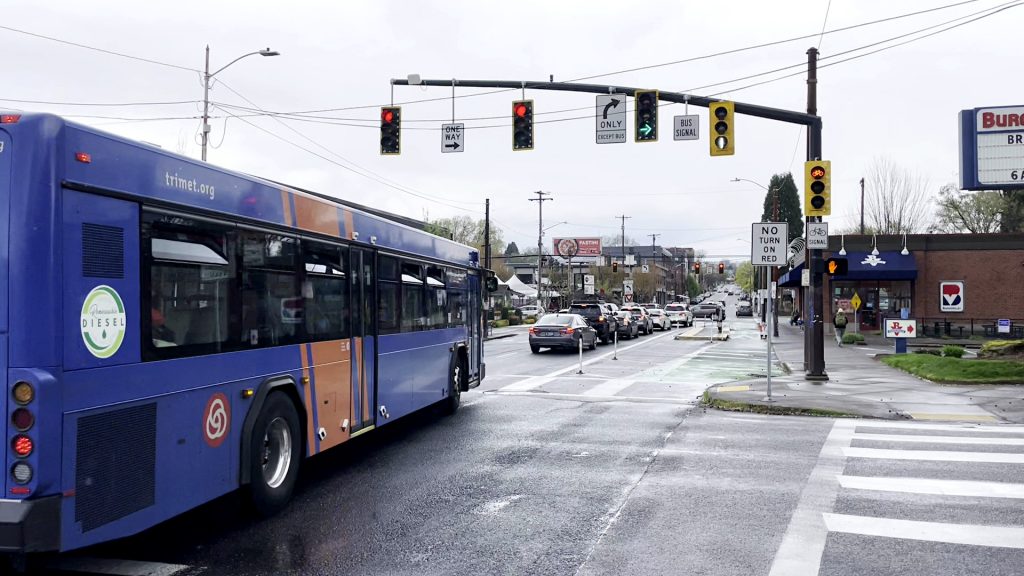Transit signal priority makes bus travel faster and more reliable by moving our riders around traffic

No one likes being stuck in traffic.
For bus riders, however, TriMet has a workaround. In partnership with the Portland Bureau of Transportation, we’re making it easier for buses to move through intersections — and past heavy traffic. That means riders can reach their destination faster on the bus than they would by driving!
A bus-only signal is now online at the intersection of Southeast Hawthorne Boulevard and 11th Avenue in Portland. That signal is part of a network of recent improvements on the Southeast Hawthorne and Madison Street couplet, benefiting four popular bus lines.
This new system saves riders in this corridor nearly 30 seconds, on average, every time they go by bus. How is that possible? We use cutting-edge technology that reduces the amount of time buses have to wait at red lights. Powered by artificial intelligence, transit signal priority is changing the game for bus travel on Portland’s east side.
The science behind the signal
Just like every other vehicle on the road, TriMet buses have to contend with rush-hour jams and other traffic delays. Our buses share the road with passenger vehicles, semi-trucks, bicycles, motorcycles, school buses, motorized scooters and more.
Our buses can’t avoid traffic altogether. With transit signal priority, however, traffic signals get an automated alert when a bus is approaching. This changes the timing of the light, giving the bus a green light to proceed. Seven signals along Hawthorne/Madison have now been improved with this technology. These signals communicate with buses and each other using a cloud-based network, and they harness the power of artificial intelligence to keep buses on the move.
A bus-only signal, like the one at Hawthorne and 11th, can even allow buses to safely proceed after the light turns red for other vehicles, or give them the go-ahead before the light turns green for everyone else. Thanks to this bus-only signal, our buses can move ahead of the traffic flow and serve the stop at Southeast 12th Avenue.
The signal is designed with safety in mind. Having two identical sets of lights, one for buses and one for everyone else, would be confusing. Instead, the bus-only signal displays simple icons. Whether the main light is green, yellow or red, our bus operators can see the icon displayed by that bus-only signal and know whether to stop or go.
Altogether, transit signal priority means riders spend less time sitting in traffic, and it means buses arrive on time more often, too.
Time savings
Transit signal priority along Hawthorne/Madison, between 12th Avenue and Grand Avenue, builds on the success of the transit-only Rose Lanes that are painted on these major roads.
Together, these innovations reduce the amount of time that buses on Line 6-Martin Luther King Jr Blvd, Line 10-Harold St, Line 14-Hawthorne/Foster and Line 70-12th/NE 33rd Ave — lines with a combined weekly ridership of more than 68,500 — have to wait due to red lights and congestion, even when traffic is heavy.
As we’ve implemented transit signal priority in this corridor, we’ve seen time savings upward of 20 seconds per trip. In some cases, it’s closer to 40 seconds. Those savings add up, helping to keep our buses on time and get riders to their destination faster throughout the day.
We know transit signal priority works, because we’ve seen it in action on TriMet FX®. Our Frequent Express line, FX2-Division, saves up to six minutes in each direction thanks to a transit signal priority network, as well as Rose Lanes along Southeast Division Street. There are 57 traffic signals in this network, including 11 bus-only signals, along Division Street from Cleveland Avenue in Gresham to Southeast 11th Avenue in Portland.
Working together with our local partners, we plan to add transit signal priority in other congestion-prone parts of our service area, making bus a better alternative to driving for more residents.
